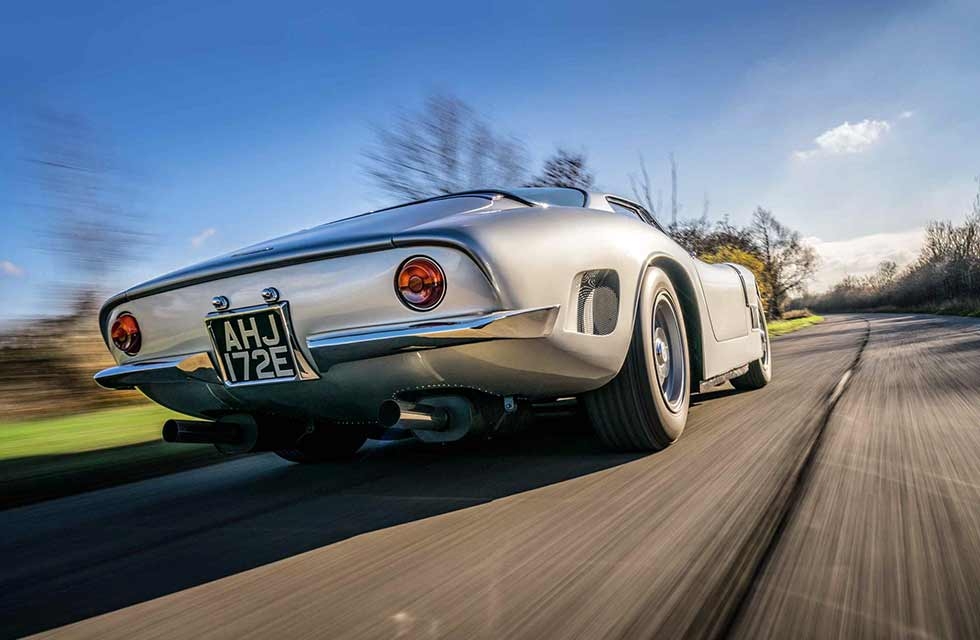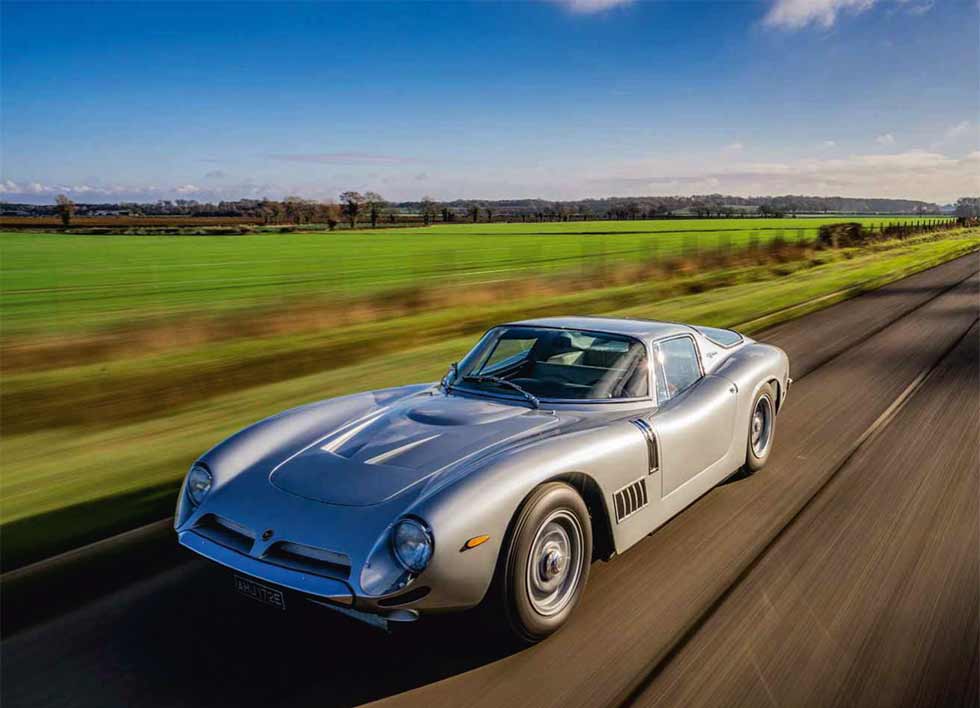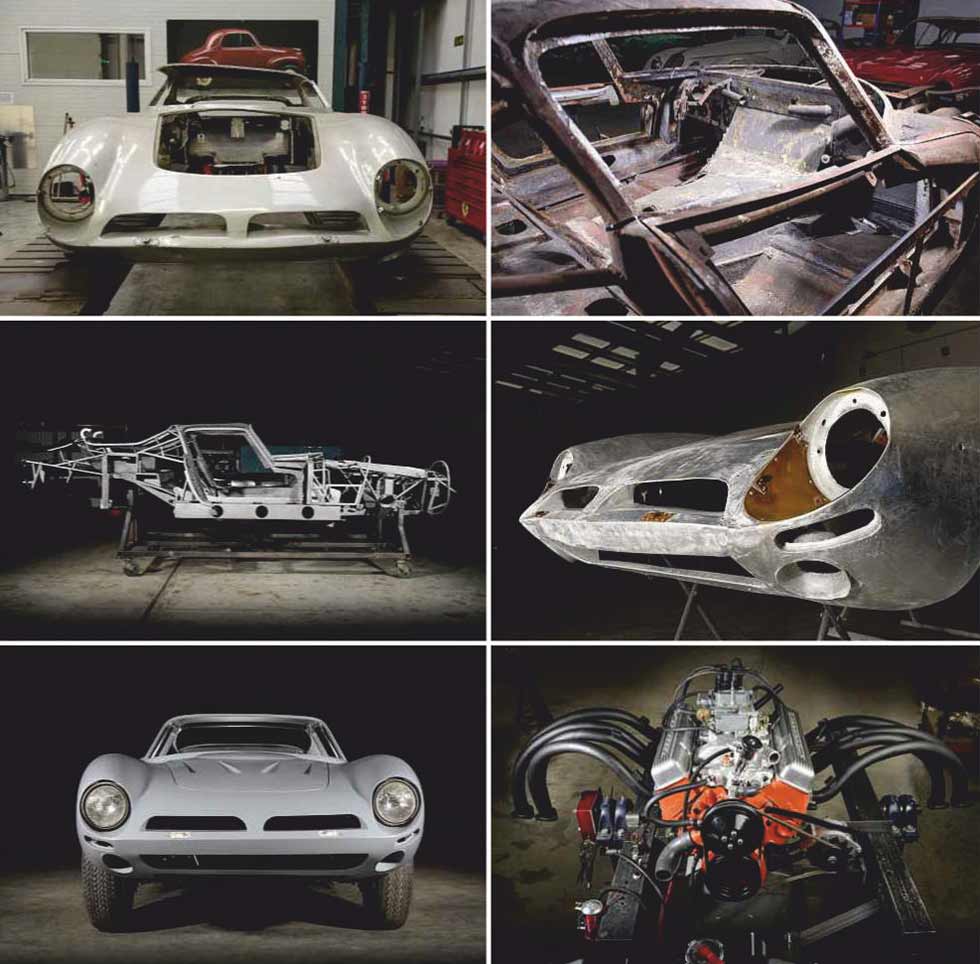
Ardent car enthusiast and Coldplay bassist Guy Berryman commissioned the restoration of this fabulous Bizzarrini 5300 GT. Drive-My drives the thrilling result. Words Jethro Bovingdon. Photography Tim Andrew.
MIND-BLOWING BIZZARRINI 5300 GT RESTORATION
Coldplay bassist’s epic restoration driven
Giotto Bizzarrini was a skilled test driver and engineer, and the father of the Ferrari 250 GTO. After he left Ferrari he created the 5300 GT in his own name, and described it as ‘GTO 2.0’. It was built primarily for racing, but the Stradale version makes even a freezing cold day in the Cotswolds feel like a long summer’s evening at Le Mans.

He’d been headhunted by Enzo from Alfa Romeo in 1957 and was soon in his element designing, testing and refining experimental sports cars to compete in GT racing around the world. He lived and breathed motorsport and was given total freedom to push the boundaries. ‘Ferrari gave me everything,’ Bizzarrini later said. ‘Mentality, technique… they had given me a great deal of responsibility without any captain who commanded me.’
‘I love watching these things gliding around Goodwood in a constant state of slip, but it feels controlled on the road’

‘I’m wondering if there’s anything I’d do differently. A hotter engine? Around 450bhp should do it’
With all we’ve heard or read about Enzo Ferrari, it’s difficult to imagine the kind of freedom that Bizzarrini describes. Later he would learn that it could be taken away as quickly as it had been granted. However, before the fallout came the masterpiece. In 1960 Bizzarrini began to work on a radical evolution of the 250 GT SWB, creating a more aerodynamic body at Pisa University’s wind-tunnel, lowering the dry-sump 3.0-litre V12 and pushing it further back in the chassis, the 250 GTO was launched in ’1962 and the rest, as they say, is history.
By 1962, so was Giotto Bizzarrini. Call it ‘the Night of the Long Knives’, ‘the Great Walkout’ or ‘the Palace Revolt’, but the catalyst was sales manager Girolamo Gardinis ultimatum to Enzo. He’d grown tired of Enzos wife Laura interfering with matters he felt weren’t her concern and said he couldn’t stay if she was allowed to continue, ‘then you are fired from this moment on,’ replied Enzo. In the days that followed, Bizzarrini, engineer Carlo Chiti, team manager Romolo Tavoni and others wrote a letter in support of Gardini. And in October 1961 they were gone, too.
You could easily write a War and Peace-style epic on Bizzarrinis career and life, particularly around this tumultuous time. In the next years there were multiple projects, from ATS and Scuderia Serenissima to consulting for Lamborghini and working with Renzo Rivolta on the Iso Grifo, an imposing, front-engined Gran Turismo in the traditional sense. Although Rivolta had little interest in motorsport, Bizzarrini was always trying to steer the project towards his real passion. And after trying a prototype he’d found his next race-car power source: ‘I especially liked the Corvette engine. It was superior to Ferraris engines, having the same power but with more immediate throttle response.’ Bizzarrini developed the Grifo A3/L (for lusso or ‘luxury’) and simultaneously designed a more extreme version for competition, the A3/C. Both were launched at 1963 s Turin motor show.

As he had with the GTO and its engine, Bizzarrini concentrated on getting that 5.4-litre V8 as low down and far back in the chassis as possible for the A3/C, which went on to become the 5300 GT pictured here. However, the monocoque chassis and de Dion rear end gave him a platform superior to the Ferraris on which to work and the result was, V8 engine apart, the natural successor to the GTO from an engineering point of view.
Styled by Giugiaro at Bertone, its body constructed at Piero Drogo’s Carrozzeria Sports Cars in Modena and standing just 43in tall, it was and remains a stunning piece of design and engineering, the Iso Grifo A3/Cs greatest moment was when it won its class and finished ninth overall at Le Mans in 1965, even while Bizzarrini was separating from Iso and adopting the A3/C as his own. The renamed 5300 GTs, in both Strada and Corsa versions, were simply badged Bizzarrini. Around 147 Iso Grifo A3/ Cs and Bizzarrini 5300 GTs were built in Livorno, Italy, up to production’s end in 1968.
I confess that I didn’t know all this when I arrived at restoration specialist Thornley Kelham to see and – gulp – drive the 1967 Bizzarrini 5300 GT Strada it has recently restored for enthusiast, collector, Coldplay bassist and my new favourite person, Guy Berryman. What I did know was that I’d seen these cars at Goodwood, Spa and the Silverstone Classic and that I loved them to death, the shape, the sound, the way they seem to almost fly along, sharp nose pointing up, rear hunkered down, and then float around the turns in the sort of four-wheel drifts most of us can only dream about. And the name. Bizzarrini. Could it be any more exotic?
Even among massed ranks of simply beautiful Lancia Aurelias and Flaminias, Porsche 356 shells and near-finished projects at Thornley Kelhams amazing facility, the Bizzarrini has star quality. Simon Thornley and Wayne Kelham talk me around the car and the restoration process, this is chassis IA3*0276, a 1967 5300 Strada that was delivered on 26 June of said year to its first owner in Rome. At Berryman’s insistence it’s been restored with fastidious attention to detail and originality as the highest priority, thankfully I’m recording what they say because it’s not easy to listen when there’s a Bizzarrini nearby and you’re holding the key.
We talk for what feels like an eternity and I thread my legs awkwardly under the original wood-rimmed Grand Prix steering wheel just to make sure I fit. It is tiny in here and I have to shuffle way down in the already heavily reclined seats just to stop my head hitting the roof. It’s worth it, though. What a view! the steering wheel is slim in your hands and has a deep red centre badge emblazoned with a white enamel eagle, its wings outstretched. Gold lettering reads ‘BIZZARRINI’ in a semi-circle from wing tip to wing tip, and then ‘LIVORNO’ in smaller letters completes the circle at the bottom. Behind it, there’s a revcounter on the left with orange markings two segments up from ‘50’, the red starts a couple of marks short of ‘60’ and yet it reads to a big, dramatic ‘70’. the speedo on the right – perhaps also with an eye on the dramatic – goes to 320km/h.
I shadow-box a few shifts of the four-speed gearbox at a standstill, the footwell is tight and the clutch is heavy, but the shift itself is very short and feels very mechanical, here’s no Ferrari-style open gate but the linkages make a noise to evoke that tradition, the gearlever is way over to the left of the transmission tunnel, just a handspan away from where you grip the wheel. Perfect. Simon invites me to fire it up and then Wayne asks if I’m OK ‘to go straight out on your own’. I try to sound confident with my reply and I guess it works, the roller door is raised and I’m ushered out into the sunshine.
The intimidation factor is high. I’m still not fully settled into the laid-back driving position, vision via the rear-view mirror is pathetic – the almost-flat rear glass, bright sunshine and a cream leather-lined boot floor combine to create a superb reflection of Thornley Kelhams fine trimming skills but not much else – and there are no side mirrors. At least the big, super-smooth and surprisingly quiet V8 is forgiving, allowing me to drift away into the Cotswolds with very few revs and zero drama.
the surprisingly easy-going ride and well- mannered V8 do create a passable impression of a road car. But the way you feel the V8 encroaching into the cabin, the impossibly low driving position and the hefty weight of the clutch and gearshift actions give unsubtle clues that Giotto was more worried about aerodynamics, weight distribution and the centre of gravity than the mundanity of Cirencester’s mini-roundabouts and demonic white van drivers. It gets pretty hot pretty quickly in here, too.
I might be sweating over the seven-figure value and the lack of air-con, but it takes just a mile or two to feel the dynamic quality of the 5300 GT. Giotto was right about the engine. In road trim with around 385bhp it sounds slightly soft-edged rather than nape-prickling like a Ferrari V12, but the torque is addictive and shoves this circa-1200kg wedge of aluminium down the road with immediacy and ever-growing intensity. It’s right in there with you, too. So far back is the engine that the distributor is accessed through a panel atop the dash.
The ride really is sophisticated, Koni dampers reading the road surface with subtlety and easy control. However, unlike most cars that get more supple with speed, the Bizzarrini actually seems to push down harder on its Michelin XWXs’ tread-blocks the faster you go. Low- speed suppleness melds into high-speed control and absolutely clear communication. It’s an unusual but fantastic feeling to sense the 5300 GT growing in stature as speeds rise, imparting more and more confidence and information to the driver. It really finds its range as the town disappears and the tree-lined roads that cut across the Cotswolds start to ebb and flow with the rolling topography.
The biggest surprise to me is the four-speed ’box. the action is precise and, although first is very long (good for nearly 60mph), second and third are nice and close, which keeps the revs up and reveals the other side of the engine’s character-adeliciously angry top-end delivery.
This physical but tightly defined gearbox action, the hefty steering weight and the bruising punch of the engine all feel perfectly matched. Its an easy car to drive and it doesn’t spring any surprises, mostly because of the intuitive control weights and responses.
The braking system is up to the task, too. Much as I love watching these things gliding around Goodwood in a constant state of slip, on the road all feels controlled, hooked-up and with traction and grip to spare, there are hints, though, of what it might feel like to experience the Bizzarrini at full stretch.
It must be magical to drive into that zone and stay there because glimpses of the 5300’s ultimate balance on these damp, leaf-strewn roads reveal a surprising agility. You can really feel the benefits of the engine placement in its effect on the front end’s response, and with the de Dion rear end matching that precision the Bizzarrini flows along, responding cleanly, consistently and as one to every steering input.
I’ll admit I’m a very long way from pushing this rare and valuable car to the limit in near-freezing conditions, but on every straight I hang on to just a few more revs, brake a little later into each turn and try to get earlier and earlier onto the throttle, the Bizzarrini just eats it up. The racecars – some of which featured lightweight glassfibre bodywork and, later, 7.0-litre engines – must have been a riot.
I greatly admire Berryman’s commitment to bringing this incredible car back to factory standard and Thornley Kelhams expertise in doing so, but I find myself wondering if there’s anything I’d do differently. I mean, Bizzarrini himself tweaked and evolved wherever he could… so where’s the harm? I conclude that I’d put in a hotter engine. Around 450bhp should do it, plus a bit more aural volume, this is no GT car so exaggerating the noise and the drama seems wholly correct. I’d fit air-con, too. A few kilos is a small price to pay to make the car more useable. Oh, and mirrors. I would want some mirrors for, y’know, seeing and not crashing into stuff.
But I think that’s it. The rest is just so cohesive, so evocative of its era. Even without the intrigue of the Giotto Bizzarrini story’s twists and turns, without the Le Mans success, even without the spectre of the 250 GTO, this thing stands up as a unique and wonderfully exciting experience. I adore the way it looks, I grew to love the laid-back, legs-splayed, straight-arms driving position. And the view out with the world framed by those sculpted wings that sit right at eye level is extraordinary. Physical, intense and every inch as exotic an experience as the looks and name suggest, the 5300 GT more than lives up to the fantasy.
Giotto Bizzarrini, now 92 years of age, really is a significant figure and his work rate in the early ’60s was phenomenal: the 250 GTO, the Iso Grifos, the ATS road and F1 cars all tumbled out of his mind in quick succession. During this fevered period Bizzarrini had another project coming to fruition, too. Ferruccio Lamborghini commissioned him to design a new V12 engine for his Ferrari-rivalling 350 GT. the first 3.5-litre engine fired up in ’1963 and produced 370bhp at 9000rpm, and Bizzarrini had plans to reach over 400bhp and 11,000rpm. It went on to power the Miura, the Countach, the Diablo and the Murcielago.
Few engineers have been so central to so many seminal road and racing cars. To drive a car bearing his own name is something very special indeed.
THANKS TO ‘ Thornley Kelham, www.Thornleykelham.com, and Bizzarrini Registrar and author Jack Koobs de Hartog.
TECHNICAL DATA FILE SPECIFICATIONS 1967 Bizzarrini 5300 GT
Engine 5354cc V8, OHV, Holley four-barrel carburetor
Max Power 385bhp @ 6000rpm / DIN nett
Max Torque 376lb ft @ 3500rpm / DIN nett
Transmission Four-speed manual, rear-wheel drive
Steering Recirculating ball
Suspension
Front: double wishbones, coil springs, telescopic dampers, anti-roll-bar.
Rear: de Dion axle, radius arms, Watt’s linkage, coil springs, telescopic dampers
Brakes All Discs
Weight 1252kg (dry)
Top speed 165mph
0-62mph 6.4sec
This page and opposite: Bovingdon shares the compact cabin with the gearbox, some of the engine and a lot of heat; even the Cotswolds feel like a racetrack when you’re driving a Bizzarrini 5300 GT. This page and facing page: Restoration involved a stripdown to bare bones and much remedial metalwork, retaining a correctly imperfect look where possible; Chevrolet Corvette engine features impressive exhaust headers.
Above and below: In profile the 5300 seems to crouch between its wheels; Kelham and Thornley give Bovingdon (left) the lowdown.
WHAT TO GET EXACTLY RIGHT – AND WHAT TO LEAVE ALONE
Thornley Kelham and Guy Berryman are kindred spirits. ‘I need all of the details – even the ones you can’t see – to be done exactly as they were originally,’ explains Berryman. Thornley Kelham has recently enjoyed success and plenty of attention with its Lancia Aurelia ‘Outlaw’, featuring a lowered roofline, a fuel-injected Flaminia engine and other modifications, but the company’s core work remains in authentic restorations that meet even Guy’s exacting standards.
Wayne Kelham takes up the story. ‘With the Bizzarrini project we had a very good starting point,’ he says. ‘It was a largely complete and unmolested car. Details on it were then cross-referenced with various books we had already sourced, to ascertain everything was as it seemed.’

Despite these encouraging signs, the restoration left no stone unturned. ‘It couldn’t have come further apart,’ he laughs. ‘Cars of this type of construction – alloy skins over a steel frame – take around 4000 to 4500 hours, spread over a period of between 18 and 24 months.’
The process starts with a professional ‘before’ photoshoot, followed by disassembly and cataloguing of parts and then assigning and managing any subcontractors. Once this is complete, the restoration and rebuild phases begin. In this case the metalwork, usually done in-house, was taken care of by Gary Pitney at GP Panelcraft.
The fastidious approach – it takes up to 800 hours for a bare-metal respray here, for example – pays off in the long run. ‘We were at Pebble Beach last year,’ remembers Simon Thornley, ‘and there was a car being shown that Wayne had painted 17 years ago. That level of quality and attention to detail, that’s a big part of what we’re about.’
Wayne adds: ‘Challenges on restoring cars are so varied from one to the other, but on this particular car there was actually no real show-stopper.’ Compared with some of the Lancias and Amilcars that Thornley Kelham works on, the Bizzarrini was relatively simple. ‘I guess the brakes proved tricky,’ Wayne reflects, ‘and in the end it came down to a decision based on the fact that the owner will use the car regularly. So we used units that would have plentiful spares in the future.’
Dunlop-style brakes, then, were a rare specification change. ‘Other judgments were based on how best to leave original work, such as the welding. Some of it – as with Touring and Zagato-built cars – was awful! We strengthen the areas but try to leave the aesthetic the same.’
THE LOWDOWN
Goldplay bassist Guy Berryman on his obsession with ’60s sports cars – and the Bizzarrini in particular
‘I suppose the passion for cars came from the fact that my dad had a TR3A in the garage ever since I can remember. It was up on bricks, covered in sheets and boxes… I was fascinated by the shape of this thing lurking underneath all that debris. I just like mechanical things, it’s always been in my nature.’
the passion for classic cars never went away even as Guy’s career skyrocketed. Coldplays success has allowed him to feed the obsession. ‘I started collecting seven or eight years ago,’ he explains. ‘I got an urge to get back into it. So I bought a couple of E-types, pulled them apart at my workshop at home and a big frenzy of E-type activity followed. I ended up with about a dozen of them sitting around behind sheds.’ From the TR3A to a dozen E-types… you almost wonder where the Bizzarrini fits in. ‘It’s not just British cars,’ Guy says. ‘European ’60s sports cars, I suppose, are where my interest lies. It turns on about 1961 and switches off again in 1974. Interestingly, I feel the same about music, that was a golden period.’
Below: Meeting your hero: Guy Berryman and Giotto Bizzarrini, who arrived in his Iso Fidia, at Livorno in 2013

The collection includes a 275 GTB, a Maserati Vignale Spyder, various Lancias, a Miura and now, of course, the 5300 GT.
‘I don’t think there’s any other ’60s car, or any car, that looks more exotic than a Bizzarrini,’ Guy replies when I ask him why he bought it. ‘It has a unique style that’s always challenging you. Every angle that you look at it, you fall in love with it again. Over and over.’
It wasn’t love at first sight, though. ‘It was for sale at a dealership in New York for some time. I’d go back to this dealership and look at other cars and it would still be there.
‘Then I started reading up about Bizzarrini and, of course, you don’t need to scratch very far beneath the surface to realise that not only is the story of Giotto fascinating, but also that he’s probably one of the most significant engineers ever.’ this Bizzarrini 5300 GT ticked all of the boxes for Guy, from its unusually original condition to its place in the remarkable story of Giotto Bizzarrini.
‘It wasn’t driveable/ he recalls, ‘but it was completely unmolested, unrestored, that’s what attracted me to it. I always go for originality.’ And now that it’s been so sympathetically brought back to life, Guy will drive the 5300 GT and enjoy it.
‘I like to get involved in events, whether that’s the Mille Miglia, Tour Auto or just doing a road trip around Scotland with some friends,’ he explains. ‘So I’ll definitely use it. Next year I’m going to do the Modena Centro Ore [a rally that includes closed roads and timed events at Misano, Imola and Mugello] and the Bizzarrini might be a good car to do that in.’ Well, if you need a co-driver, Guy, sign me up.






